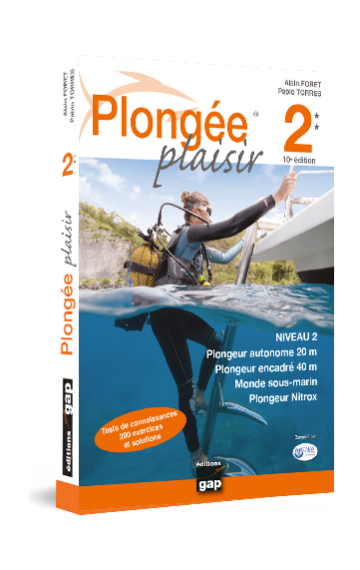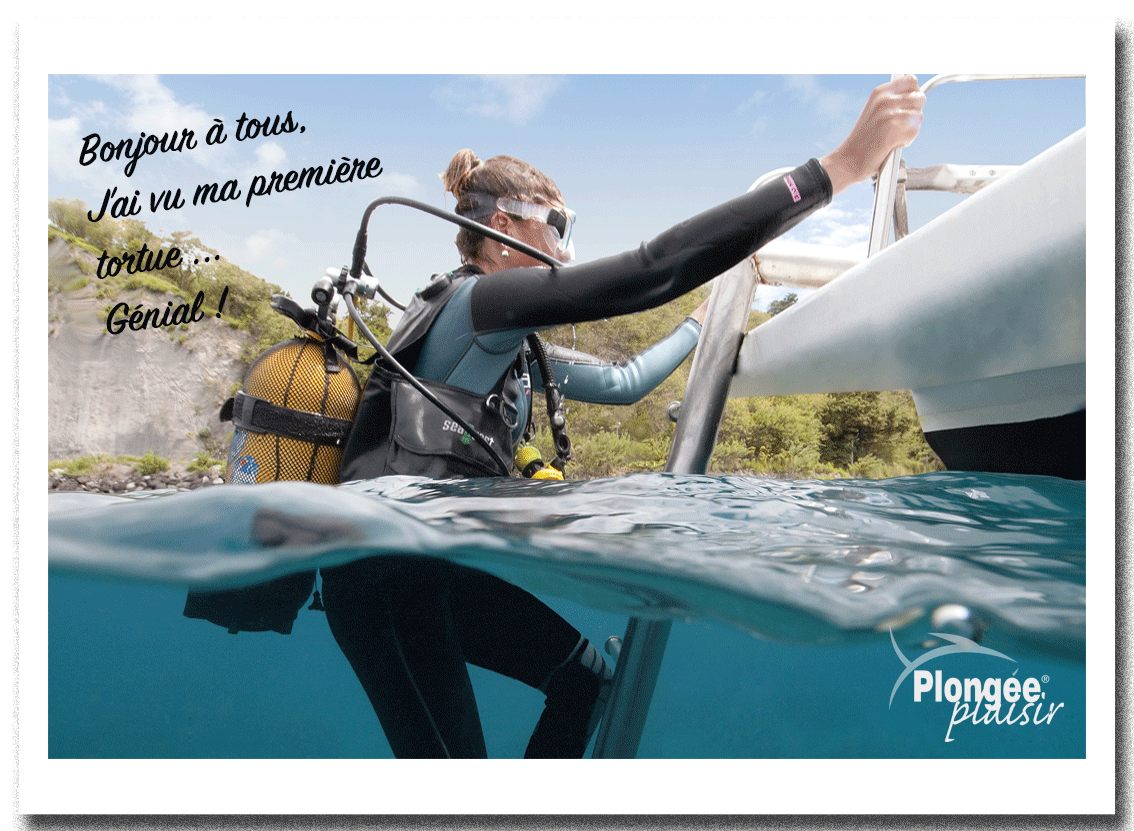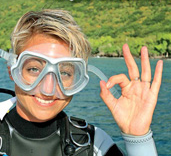
- Publisher: 288 p.
- Editor: GAP editions
- Editing: 10e édition, octobre 2022
- Available in: Paper
- ISBN: 9782 74170 7004
N ° 1 FOR DIVING TRAINING BOOKS![]()
10e édition, octobre 2022

Plongée Plaisir 2 presents all the knowledge and technical skills to be acquired for the level 2 diving certificate and the associated skills. You will also find many tests there that allow you to self-assess at your own pace.
Skills or abilities covered:
- Level 2 diver (Cmas P2 *)
- Autonomous diver 20 m (PA-20)
- Supervised diver 40 m (PE-40)
- Underwater world (environment, species identification and protection)
- Nitrox diver (PN)
Complies with the Sport Code and the program of the French Diving School (FFESSM, FSGT, ANMP, SNMP, UCPA) as well as the courses of the World Confederation of Underwater Activities (CMAS) and its member federations (French language: FLASSA-Luxembourg, FSSS-Suisse, CMAS.CH, LIFRAS-Belgium, CMAS Quebec,…).
In the press
A book full of information and photos. To dive without making a fuss.
The ExpressThanks to this book […], the reader discovers the techniques and the rules to be respected in order to be able to dive safely. The numerous photographs reinforce the educational approach.
The worldCrushing is no longer a chore.
International DiversAn effective and motivating educational approach.
Subaqua - Review of the FFESSM
They witness

Simple and user-friendly approach
Complete book, embellished with examples and exercises to be carried out to better soak up the instructions described.
BFA real “bible” to pass your level 2!
A very clear book, without unnecessary blah-blah, everything is very well explained!
You can feel it written by a passionate connoisseur!
ACThe level 1 book was already very good. This is just as much.
AL
Updates
- Arrêté du 25/11/2022 : Les plongeurs mineurs ne sont pas autorisés à évoluer en autonomie (principe général, art. A322-73 du code du sport), sauf pour les plongeurs âgés d’au moins 16 ans justifiant des aptitudes PA-12 ou PA-20 et les plongeurs âgés d’au moins 17 ans justifiant des aptitudes PA-40 (art. A322-88, autorisation parentale et autorisation du directeur de plongée).
Pour en savoir plus : https://www.plongee-plaisir.com/fr/plongeurs-mineurs-et-autonomie/
Summary
Thanks
Photographic credits
Introduction
Foreword by Albert Falco
Manual
Part 1: Techniques improvement
Level 2 - Autonomous Diver 20 m (PA-20) - Supervised Diver 40 m (PE-40)
Presentation
UL 1 - Autonomous diving at 20 m
Sheet n ° 1 Autonomy under certain conditions
Authorization from the diving director • Major divers • Training areas
Safety sheet • Notions of diving and autonomy • Compulsory individual equipment
Fixation of instruments
Sheet n ° 2 Communicating and assisting a team member
Underwater hearing • Underwater vision • Colors and depths
Write underwater (slate) • Main signs of communication • Assist a diver
Sheet n ° 3 Ballasting and immersion
Notions of buoyancy • Actual weight • Apparent weight • Archimedean thrust
Factors influencing buoyancy
Sheet n ° 4 Air consumption and depth
Pressure • Compressed air • Air autonomy decreases with depth
Autonomy calculations based on air reserves and diver consumption
Boyle-Mariotte's Law • Factors influencing our air consumption
Sheet n ° 5 Learning to find your way
Orientation: relevant landmarks (sun, coast, depth, current,
characteristic elements, diving course) • Orientation in the absence of landmarks
(determine a course, follow a course without deviating, evaluate a distance, change course)
Choosing a compass • Electronic compasses (dive computers)
Sheet n ° 6 Using a landing parachute
Report to the person providing surface security
Make yourself known to boaters • Deploy a parachute underwater
Knowledge test n ° 1
UL 2 - Risk prevention
Sheet n ° 7 Rules of good practice
Rule n ° 1: An annual medical certificate • Rule n ° 2: A gradual return to diving
Rule n ° 3: Rest and healthy lifestyle • Rule n ° 4: Physical exercise • Contraindications
Sheet n ° 8 Prevention of barotrauma
Definition: trauma due to pressure variations on closed volumes
Ears (most common, often mild) • Lung overpressure (very severe,
fortunately easy to avoid) • Sinuses • Mask veneer • Teeth
Stomach and intestines
Sheet n ° 9 So as not to get out of breath
Risks associated with shortness of breath: air failure, panic, drowning, overpressure in the lungs
Mechanism • Action to be taken • Prevention
Sheet n ° 10 Cold and thermoregulation
Mechanism • Action to be taken • Prevention
Factsheet n ° 11 Prevention of the risk of drowning
Causes and mechanisms • What to do • Prevention
Sheet n ° 12 Marine animals and associated risks
Burns • Bites • Stings
Sheet n ° 13 The current
Dives with current • Sense of exploration • Avoid shortness of breath
Security instruments
Sheet n ° 14 The waves
On board the boat • On the surface • At the end of the dive
Sheet n ° 15 Troubled waters
Avoid losing your team • Adapt your exploration
Sheet n ° 16 Caves and tunnels
Sheet n ° 17 Wrecks
Sheet n ° 18 Night dives
Specificities • Night signs
Sheet n ° 19 Nets or ropes
Risks • Prevention • Safety instruments: knife, scissors, wire cutter
Sheet n ° 20 Boats
Risks (propellers) • Prevention
Sheet n ° 21 Freediving or free diving
Performance improvement tips • Disciplines • Risk prevention
Sheet n ° 22 Diver's insurance
Liability insurance (RC) • Individual accident insurance
Existing contracts • Notions of civil and criminal liability
Assistance agreement • Equipment insurance
Knowledge test n ° 2
UL 3 - Desaturation
Sheet n ° 23 The risks of desaturation
Presentation of the mechanism • Possible consequences • What to do
Permeable Ovale Foramen (FOP) • 4 prevention rules: 1. Compliance with the protocol
2. Taking into account the contributing factors 3. Avoiding risky behavior
4. Avoid risk profiles
Sheet n ° 24 Desaturation procedures
Desaturation models • Dive computers • Ascent rate
The levels • Advice
Sheet n ° 25 Use of dive computers
Computers and dive tables: what are the differences? • Limits • Before diving,
on the surface • While diving • Returning to the surface • Dive log • 5 rules for
dive with a computer
Sheet n ° 26 Special procedures
Heterogeneous procedures • Emergency procedures
Sheet n ° 27 Using the MN90 tables
Presentation • "Single" or "single" dive • In the event of a slow ascent
A second dive during the day: successive dive
In the event of a consecutive or additive dive • In the event of an accidental ascent
or abnormal (rapid ascent, interruption of levels)
Knowledge test n ° 3
UL 4 - Supervised dive at 40 m
Sheet n ° 28 Dives at 20 m and dives at 40 m, what are the differences?
Sheet n ° 29 All dives at 40 m are not the same
Presentation • Conditions to be fulfilled • Equipment • Descent • Stabilization
Sheet n ° 30 Managing air reserves and the risk of air failure
Air failure • Communication • Know your consumption • What to do
Sheet n ° 31 Risks of shortness of breath
Specificity of dives in the 20 to 40 m zone (see sheet n ° 9 for the general framework)
Sheet n ° 32 Understanding narcosis
Sensitivity factors • What the diver feels • To avoid being narcotic
Risk of loss of team members • The ascent phase and the stages
Knowledge test n ° 4
UL 5 - The material
Sheet n ° 33 Instruments for measuring parameters
Depth gauge • Dive computer: desaturation management, alarm, display
and readability, air management, nitrox, penalizing factors, batteries, altitude, dive planning,
interview
Sheet n ° 34 Regulators
Operating principle • Notions of tightness • Operation • Risk of breakdown
Compensation • Piston / diaphragm • DIN / Caliper • Custom settings
Sheet n ° 35 The waistcoat
Types of vests • Models • Volumes
Sheet n ° 36 Scuba tanks
Periodic inspection • Periodic requalification • Exceptional regime: TIV
Taps • Mandatory information • Choose a bottle
Sheet n ° 37 Dry suits
Knowledge test n ° 5
UL 6 - Certification bodies
Sheet n ° 38 Diving in France
Sheet n ° 39 The federations
National level and decentralized bodies (OD)
Members (associative clubs and commercial structures) • Diving federations
Sheet n ° 40 The FFESSM: delegated federation
Administration • Members • License • Deconcentrated bodies • Commissions
Sheet n ° 41 The FSGT
Sheet n ° 42 Professional unions
ANMP • SNMP
Sheet n ° 43 CMAS
Sheet n ° 44 International certification agencies
PADI • SSI • NAUI
Final level 2 diver test
Part 2 - The underwater world
Sheet n ° 45 Oceans
Source of life and great regulators • Zones of depth • Light and life
Temperature
Sheet n ° 46 Planet Water
Waves • Swell • Current • Salt • How do fish float?
Do fish have blood? • Camouflage and protection • Do the fish drink?
Plankton
Sheet n ° 47 The underwater environment
Rocky bottoms • Drop-offs • Sand • Open water • Giant algae (laminaria)
Coral reefs • Mangroves
Sheet n ° 48 Underwater life
Classification of species • Identification keys
Sheet n ° 49 The vegetable kingdom
Algae • Flowering plants
Sheet n ° 50 The animal kingdom: invertebrates
Sponges • Cnidarians: jellyfish, anemones, sea fans, corals (hard, black, soft,
Mediterranean red, fire coral) • Bryozoa: sea rose, Neptune lace,
false coral • Worms: spirographs, sabelles, planarians, bonellies
Crustaceans: shrimps, lobsters, lobsters, crabs
Molluscs: gastropods (slugs, snails), bivalves (oysters, mussels, giant clams),
Cephalopods (octopus, cuttlefish, squid) • Echinoderms: starfish, brittle stars, sea urchins,
sea cucumbers • Ascidians (tunicates)
Sheet n ° 51 The animal kingdom: vertebrates
Cartilaginous fish (rays, sharks) • Bony fish from temperate seas:
castagnoles, wrasse, blenny, crenilabra, wrasse, mullet, red mullet, moray eel, conger eel,
sea bream, oblades, sars, saupes, serrans, wolves (bars), corbs, mostelles, pouts, capelin, lieus, groupers, scorpion fish, saint-pierre, sphyrenes (barracuda, bécunes)
Bony fish from coral reefs: parrotfish, triggerfish, wrasse,
lionfish, coachfish, soldierfish, bigeye, anthias, snappers, tropical groupers, angelfish, batfish, surgeonfish, stonefish, sweetlips, crocodilefish,
pterois, pufferfish, boxfish
Marine reptiles: snakes, marine iguanas, marine crocodiles, turtles
Marine mammals: delphinids (orcas, pilot whales, dolphins), beluga, narwhal, sperm whales, porpoises, whales, manatees, dugongs, sea lions, seals, walruses
Ecosystems • Life together
Sheet n ° 52 Approach to underwater species
Rule n ° 1: no noise or sudden movement • Rule n ° 2: do not get between the fish
and the current • Rule n ° 3: do not get between the light and the fish
Factsheet n ° 53 Protecting nature
The causes • The vision of Jean-Michel Cousteau • The responsible diver charter
Longitude 181 Nature
Sheet n ° 54 The underwater image (photo, video)
Test on the underwater world
Part 3 - Nitrox Diver (PN)
Sheet n ° 55 Nitrox Plunger
Nitrox: why? • Nitrox: distinctive colors • Where to dive with Nitrox
Nitrox diving in France • Prerogatives of a Nitrox Diver (PN)
The notion of floor depth • Setting up your computer
Nitrox tables • Risk of hyperoxia • Control of oxygen percentage
Nitrox diver knowledge test
To know more
Units of measure and conversion factors
Diving differently (altitude, under the ice)
A little history of diving
The diver's vocabulary
Small dictionary French, English, Spanish
Thematic index
To discover at Editions GAP
Books and educational materials Plong Plaisir
Books edited and distributed by Editions GAP
Printed on certified paper made from paper pulp from sustainably managed forests. The ink used is based on vegetable oil, the printing press adopts a progressive environmental approach validated by Imprim'vert certification.
A question, a suggestion, talk to the author, Alain FORET: Click here.

